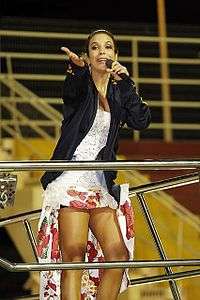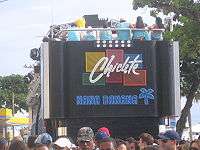Trio elétrico


Trio Elétrico (Portuguese pronunciation: [ˈtɾiw eˈlɛtɾiku], electric trio) is a kind of truck or float equipped with a high power sound system and a music group on the roof, playing for the crowd. It was created in Bahia specifically for Carnival and it is now used in similar events in other districts and countries. This setup is used in Brazilian Carnival inside the blocos carnavalescos and other festivals in Brazil, specially in micaretas . The idea was introduced in 1949 during a carnival in Bahia by the duo Dodô e Osmar (Adolfo Nascimento and Osmar Macedo).
Some Brazilian artists have been known to sing on a Trio such as Elba Ramalho, Daniela Mercury, Ivete Sangalo, Saulo Fernandes, Cláudia Leitte, Carlinhos Brown (from Timbalada), Asa de Águia and Chiclete com Banana. The popular Brazilian singer Caetano Veloso made famous the Trio Elétrico in the song, Atrás do Trio Elétrico só não vai quem já morreu - "Only the dead do not go after the Trio Elétrico".
History
The origins of the trio elétrico come from the "dupla eletrica" ("Electric Duo"), the two friends Adolfo Antônio Nascimento (Dodô) and Osmar Álvares de Macêdo, who decided, in 1950, to fix an old Ford Model T to perform their self-made electric instrument, known as pau eletrico (electric log), during Bahia carnival. They drove through the streets playing music powered by the car battery. The show took place in the city centre at 5 pm on carnival Sunday and attracted a large crowd.
The name "trio elétrico" was coined in 1951 when Dodô and Osmar invited a friend to perform with them, the architect Temístocles Aragão. They played through Salvador in a Chrysler pick-up. That is how the electric pair became the electric trio. Though the name was created for the band, it ended up being the name of their invention.
Another invention from Bahia, the "micaretas" (an out-of-season Carnival) began using the trios or floats. Today, there is a huge industry for the production, maintenance and leasing of trios. Many new artists are discovered on trios.
In the year of 1983, a trio built in Italy was inaugurated in Piazza Navona in the presence of 80 thousand people who danced to the electric sound of Dodô, Osmar and Armandinho. That was the first time a trio was featured out of Brazil.
In 1985, invited by students of the University of Toulouse, in France, Armandinho, Dodô and Osmar traveled once more to Europe to take some of Carnival to more than 100 thousand people in Toulouse.
The trio is known worldwide as one of the symbols of Brazilian culture, its music and its Carnival.
External links
- (English) Trio Electrico at Europe.
- (English) The origins of the Trio Eletrico in Bahia.
- (Portuguese) - Brazilian Trio Elétrico for Carnival.